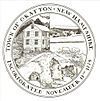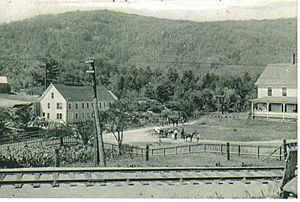Grafton, New Hampshire facts for kids
Quick facts for kids
Grafton, New Hampshire
|
||
|---|---|---|
|
Town
|
||

Town hall
|
||
|
||

Location in Grafton County, New Hampshire
|
||
| Country | United States | |
| State | New Hampshire | |
| County | Grafton | |
| Incorporated | 1778 | |
| Villages |
|
|
| Area | ||
| • Total | 42.4 sq mi (109.8 km2) | |
| • Land | 41.5 sq mi (107.4 km2) | |
| • Water | 0.9 sq mi (2.4 km2) 2.20% | |
| Elevation | 870 ft (270 m) | |
| Population
(2020)
|
||
| • Total | 1,385 | |
| • Density | 33/sq mi (12.9/km2) | |
| Time zone | UTC-5 (Eastern) | |
| • Summer (DST) | UTC-4 (Eastern) | |
| ZIP code |
03240
|
|
| Area code(s) | 603 | |
| FIPS code | 33-30820 | |
| GNIS feature ID | 0873609 | |
Grafton is a town in Grafton County, New Hampshire, United States. The population was 1,385 at the 2020 census.
History
Originally granted in 1761, and re-granted in 1769, Grafton, like the county it resides in, takes its name from Augustus FitzRoy, 3rd Duke of Grafton, a relative of colonial governor Benning Wentworth. Grafton was incorporated in 1778.
Historically, Grafton's economic base consisted of subsistence farming, small-scale industry, and mining. Several mica mines and granite quarries once dotted the town's landscape, most notably Ruggles Mine.
Geography
According to the United States Census Bureau, the town has a total area of 42.6 square miles (110.3 km2), of which 41.7 square miles (108.0 km2) is land and 0.9 square miles (2.3 km2) is water, comprising 2.19% of the town. The highest point in Grafton is the summit of Melvin Mountain, at 2,177 feet (664 m) above sea level. Grafton Pond is in the western part of town. Grafton lies mostly within the Merrimack River watershed, though the western edge of town is in the Connecticut River watershed.
Demographics
| Historical population | |||
|---|---|---|---|
| Census | Pop. | %± | |
| 1790 | 403 | — | |
| 1800 | 682 | 69.2% | |
| 1810 | 931 | 36.5% | |
| 1820 | 1,094 | 17.5% | |
| 1830 | 1,207 | 10.3% | |
| 1840 | 1,201 | −0.5% | |
| 1850 | 1,259 | 4.8% | |
| 1860 | 1,150 | −8.7% | |
| 1870 | 907 | −21.1% | |
| 1880 | 934 | 3.0% | |
| 1890 | 787 | −15.7% | |
| 1900 | 748 | −5.0% | |
| 1910 | 641 | −14.3% | |
| 1920 | 554 | −13.6% | |
| 1930 | 539 | −2.7% | |
| 1940 | 552 | 2.4% | |
| 1950 | 442 | −19.9% | |
| 1960 | 348 | −21.3% | |
| 1970 | 370 | 6.3% | |
| 1980 | 739 | 99.7% | |
| 1990 | 923 | 24.9% | |
| 2000 | 1,138 | 23.3% | |
| 2010 | 1,340 | 17.8% | |
| 2020 | 1,385 | 3.4% | |
| U.S. Decennial Census | |||
As of the census of 2010, there were 1,340 people, 564 households, and 372 families residing in the town. The population density was 32.1 inhabitants per square mile (12.4/km2). There were 839 housing units at an average density of 20.1 per square mile (7.8/km2). The racial makeup of the town was 96.7% White, 0.3% African American, 0.2% Native American, 0.4% Asian, 0.1% some other race, and 2.2% from two or more races. Hispanic or Latino of any race were 1.5% of the population.
There were 564 households, out of which 24.1% had children under the age of 18 living with them, 54.4% were headed by married couples living together, 7.1% had a female householder with no husband present, and 34.0% were non-families. 26.4% of all households were made up of individuals, and 7.4% consisted of someone living alone who was 65 years of age or older. The average household size was 2.38, and the average family size was 2.84.
In the town, the population was spread out, with 18.8% under the age of 18, 5.2% from 18 to 24, 23.7% from 25 to 44, 36.5% from 45 to 64, and 14.6% who were 65 years of age or older. The median age was 45.6 years. For every 100 females, there were 108.7 males. For every 100 females age 18 and over, there were 112.1 males.
At the 2000 census, the median income for a household in the town was $38,654, and the median income for a family was $41,875. Males had a median income of $30,074 versus $23,750 for females. The per capita income for the town was $16,944. About 4.2% of families and 7.9% of the population were below the poverty line, including 10.0% of those under age 18 and 4.1% of those age 65 or over.
Free Town Project
In 2004, Grafton became the focus for Libertarians as part of the Free Town Project (a single-town version of the Free State Project). One of the goals was to advocate for legal changes. Grafton's appeal as a favorable destination was due to its absence of zoning laws and a then-low property tax rate. John Babiarz, a Grafton resident and prominent member of the Libertarian Party, encouraged libertarian people to move there.
During this time, the town's population grew by about 200 people (about 20%); nearly all of the newcomers were men. Project participants did not find themselves as welcome as they had hoped, but they voted in changes including a 30% reduction in the town's already small budget. This resulted in eliminating funding to the county's senior-citizens council, town offices going unheated during the winter, poorly maintained roads filled with potholes, and the Grafton Police Department being reduced to one officer (the police chief), who said he was unable to answer calls for service as the town had no money to repair the one police vehicle left. Other issues were inconsistent basic public services, such as trash collection. The libertarian newcomers additionally increased the town's costs by filing lawsuits against it in attempts to set various legal precedents.

The project has been associated with an increase in the number and aggressiveness of black bears in town, including entering homes, mauling people, and eating pets. A single, definitive cause for the abnormal behavior of the bears has not been proven, but it may be due to libertarian residents who refuse to buy and use bear-resistant containers, who do not dispose of waste materials (such as feces) safely, or who deliberately put out food to attract the bears to their own yards, without caring how this affected other people.
After a rash of lawsuits from Free Towners, an increase of crime, problems with bold local bears, and the first murders in the town's history, the Libertarian project ended in 2016.
Notable people
- Monroe Heath (1827–1894), mayor of Chicago from 1876 to 1879
- Myra Belle Martin (1861–1936), teacher, writer, financier in late 19th century and early 20th century
- Cyrus A. Sulloway (1839–1917), congressman
Sites of interest
- Ruggles Mine (closed)
See also
 In Spanish: Grafton (Nuevo Hampshire) para niños
In Spanish: Grafton (Nuevo Hampshire) para niños



